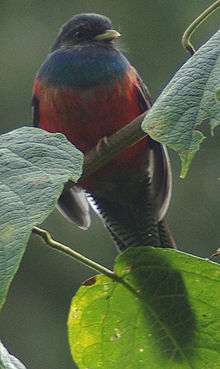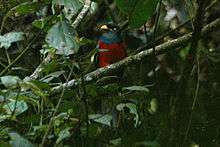Bar-tailed trogon
The bar-tailed trogon (Apaloderma vittatum) is a species of bird in the family Trogonidae.
| Bar-tailed trogon | |
|---|---|
 | |
| Male, perhaps immature, in Kenya | |
| Scientific classification | |
| Kingdom: | Animalia |
| Phylum: | Chordata |
| Class: | Aves |
| Order: | Trogoniformes |
| Family: | Trogonidae |
| Genus: | Apaloderma |
| Species: | A. vittatum |
| Binomial name | |
| Apaloderma vittatum Shelley, 1882 | |
| Synonyms | |
| |
Distribution and habitat
It is found in Angola, Burundi, Cameroon, DRC, Equatorial Guinea, Kenya, Malawi, Mozambique, Nigeria, Rwanda, Tanzania, Uganda, and Zambia.[1] It lives in forests; its preferred altitude, above about 1,600 metres (1 mile), is typically higher than that of the Narina trogon, but the two occur together in some places.[2]
Description
The bar-tailed trogon averages about 28 cm (11 inches) long. The bill and feet are yellow, and the tail, long and broad as usual for trogons, has the underside narrowly barred with black and white. The male's head is blue-black with bronze iridescence. Below the eye are two yellow or orange patches of bare skin; above the eye is a yellow or grey patch. The upper breast is iridescent from violet to blue-green; the rest of the underparts are red. The back is green and the upper surface of the tail is blue-black or purple-black. The female's head is brown with less ornamental bare skin and its throat and breast are light cinnamon; otherwise it resembles the male. The immature is similar to the female, but has a white belly and pale spots on the wings formed by the tips of the wing coverts and inner secondaries.[2]
The vocalisations are described as a yelping crescendo, "yaow, yow, yow, yow… or wuk-wuk-wuk-wuk…." The female gives "a whining chee-uu."[2]
Gallery
References
- BirdLife International (2012). "Apaloderma vittatum". IUCN Red List of Threatened Species. 2012. Retrieved 26 November 2013.CS1 maint: ref=harv (link)
- Zimmerman, Dale A.; Donald A. Turner & David J. Pearson (1999). Birds of Kenya and Northern Tanzania. Princeton University Press. pp. 134–135, 386. ISBN 0-691-01022-6.
| Wikimedia Commons has media related to Apaloderma vittatum. |


